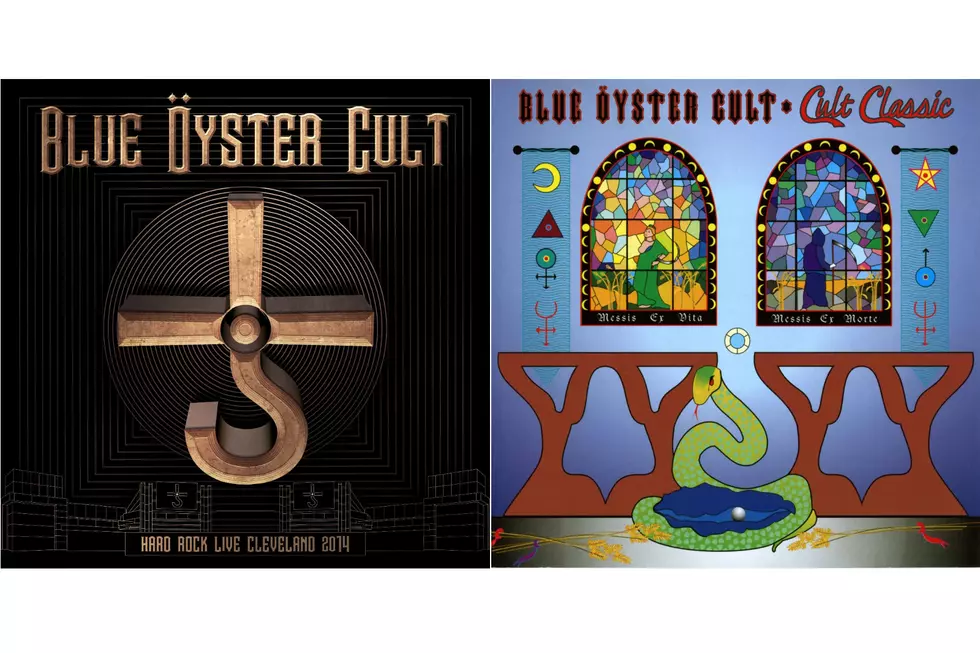
When Blue Oyster Cult Got Heavy on Their Self-Titled Debut
Blue Oyster Cult didn't emerge fully formed. Instead, their self-titled debut arrived on Jan. 16, 1972 as a sign post in their continuing development.
They'd met as members of a communal musical scene that had grown up around the State University of New York -- Stony Brook, and that free-form sense of things would guide the band early on. Reportedly inspired by a Winston Churchill speech, they initially called themselves Soft White Underbelly – then later the Stalk Forrest Group. By 1970, they'd switched to Blue Oyster Cult, at the behest of manager Sandy Pearlman, who was prone to flights of inventive fancy often populated by alien lifeforms.
"In the early days, we all lived together in a rented house in Great Neck," vocalist/guitarist Eric Bloom told the New York Times in 2000. "We'd all set up in the living room and jam, and that's how a lot of the songs of the first couple of albums came together."
An initial lineup that featured Bloom, guitarist Donald "Buck Dharma" Roeser, the late keyboard player/guitarist Allen Lanier, bassist Joe Bouchard and drummer Albert Bouchard ended up combining this early jam-band aesthetic with the sludgy, proto-metal sound of the day – coming up with something best described as a blend of Black Sabbath and the Grateful Dead.
"They were signed to Elektra for 2 1/2 years, but nothing ever came out," Joe Bouchard later told Gary James. "So, when I joined the band after I graduated from Ithaca College, we decided we would change the name and start fresh with a new approach and be less psychedelic '60s and more of the metal '70s – or hard rock '70s."
Joe's brother Albert Bouchard said the move was sparked by an A&R-man wannabe from their label. "That was our assignment: Can you sound like Columbia’s answer to Black Sabbath?" he told Glide in 2015. "So, that’s kind of where we started with our first record. It’s not a bad record and it certainly proves that we could work with that kind of darker Sabbath sound. But when we tried to tour on that record, it was a little weird cause we really didn’t know how to look or what to do."
Listen to BOC Perform 'Cities On Flame with Rock and Roll'
They were the products, however, of a different time. At the turn of the '70s, bands were given the space to develop their own unique personalities. Experiments like Blue Oyster Cult eventually paid big dividends for Columbia, even though this first album stalled at a paltry No. 172 on the Billboard chart.
"I always thought that we’ll get a record deal and make a record, and see if they allow us to make another one. And we did," Buck Dharma told Rock Cellar in 2014. "Bless the record business in those days, because you could do that. It wasn’t a situation like today where artists are given a chance to do one record, and if they don’t have a hit they’re gone from the label."
As they opened for more established legends like the Byrds, Mahavishnu Orchestra and Alice Cooper, the band slowly but surely began to find their audience – and their voice. Eventually, Dharma would take center stage.
Meanwhile, "Cities on Flame With Rock and Roll," "Stairway to the Stars" and "Then Came the Last Days of May" may not have lit up the charts, but they remained staples of Blue Oyster Cult's set list for years. They made better records, had bigger hits, but the band never forgot those humble, free-wheeling beginnings.
"We were trying on this identity of being a more dark, more ominous, heavier and more focused than we had been," Allen Bouchard told Glide. "But also, when we did that first record, we had a whole different way of writing songs and rehearsing them. ... There was a lot of collaboration because someone would bring in an idea for a song to rehearsal and would play it and we would do it as good as we could – and then somebody else might say, 'Well hey, I got an idea for that song. What if we did this for a chorus?' So, then you had that kind of mixing up of ideas, and if it worked then we would use it."
In this way, Blue Oyster Cult eventually hit upon a winning formula. They were a long way, and several more musical tweaks, from the commercial successes of 1974's Secret Treaties. That began a run in which six of the group's next eight albums went gold or platinum through 1981, when this classic lineup splintered after Fire of Unknown Origin.
An early template had been laid. “Our first record sold 100,000 copies in the first year,” Buck Dharma told Uncut in 2013. “Each one after that doubled the sales again."
See Blue Oyster Cult Among Rock’s Most Underrated Albums
More From Ultimate Classic Rock









